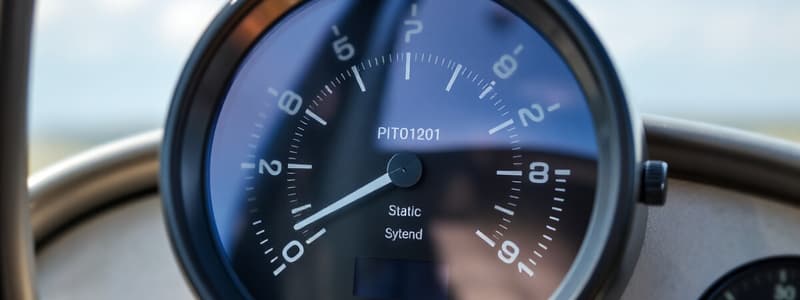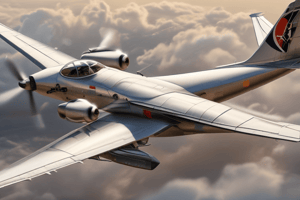Podcast
Questions and Answers
What is the primary function of the Turn Coordinator (TC)?
What is the primary function of the Turn Coordinator (TC)?
- To indicate rate and quality of turn (correct)
- To indicate speed of the aircraft
- To display altitude
- To show fuel levels
The Heading Indicator automatically aligns with magnetic north.
The Heading Indicator automatically aligns with magnetic north.
False (B)
What should a pilot do when the Turn Coordinator ball is outside the turn?
What should a pilot do when the Turn Coordinator ball is outside the turn?
Apply excessive rudder pressure in the direction the ball is exposed.
The __________ indicates the airplane's heading based on a 360 degrees azimuth.
The __________ indicates the airplane's heading based on a 360 degrees azimuth.
Match the following instruments with their primary function:
Match the following instruments with their primary function:
What does magnetic deviation measure?
What does magnetic deviation measure?
Compass card oscillation is caused by smooth flying techniques.
Compass card oscillation is caused by smooth flying techniques.
What is the primary effect of acceleration errors on a compass in the northern hemisphere?
What is the primary effect of acceleration errors on a compass in the northern hemisphere?
The angular difference between true and magnetic north is called __________.
The angular difference between true and magnetic north is called __________.
Match the following engine instruments with their functions:
Match the following engine instruments with their functions:
What is the primary function of aircraft instruments?
What is the primary function of aircraft instruments?
The Pitot tube is responsible for supplying static pressure to the aircraft instruments.
The Pitot tube is responsible for supplying static pressure to the aircraft instruments.
What are the two pressures that pitot-static instruments rely on?
What are the two pressures that pitot-static instruments rely on?
The _______ is the instrument that indicates the speed at which the airplane is moving through the air.
The _______ is the instrument that indicates the speed at which the airplane is moving through the air.
Match the types of airspeed with their definitions:
Match the types of airspeed with their definitions:
Which color-coded arc on the Airspeed Indicator indicates the normal operating range?
Which color-coded arc on the Airspeed Indicator indicates the normal operating range?
VNO is the maximum structural cruising speed a pilot must never exceed.
VNO is the maximum structural cruising speed a pilot must never exceed.
What is VSO known as?
What is VSO known as?
What is maneuvering speed (VA)?
What is maneuvering speed (VA)?
Indicated altitude is the altitude reading from the altimeter directly.
Indicated altitude is the altitude reading from the altimeter directly.
What does VSI stand for?
What does VSI stand for?
The _____ altitude is the actual height of an aircraft above the earth's surface.
The _____ altitude is the actual height of an aircraft above the earth's surface.
Match the type of altitude to its description:
Match the type of altitude to its description:
What happens if the static port is blocked?
What happens if the static port is blocked?
The gyroscope maintains its position in space due to precession.
The gyroscope maintains its position in space due to precession.
What is the function of the suction gauge in a gyroscopic instrument system?
What is the function of the suction gauge in a gyroscopic instrument system?
Flashcards
Aircraft Instruments
Aircraft Instruments
Devices that assist pilots in aircraft operation for safety and performance.
Pitot-Static System
Pitot-Static System
Instrument system using air pressure differences to measure speed and altitude.
Pitot Tube
Pitot Tube
Measures impact air pressure, affected by aircraft speed.
Static Port
Static Port
Signup and view all the flashcards
Airspeed Indicator (ASI)
Airspeed Indicator (ASI)
Signup and view all the flashcards
ASI Color Arcs
ASI Color Arcs
Signup and view all the flashcards
Altimeter
Altimeter
Signup and view all the flashcards
Vertical Speed Indicator (VSI)
Vertical Speed Indicator (VSI)
Signup and view all the flashcards
Gyroscopic Instruments
Gyroscopic Instruments
Signup and view all the flashcards
Attitude Indicator (AI)
Attitude Indicator (AI)
Signup and view all the flashcards
Turn Coordinator (TC)
Turn Coordinator (TC)
Signup and view all the flashcards
Heading Indicator (HI)
Heading Indicator (HI)
Signup and view all the flashcards
Magnetic Instruments
Magnetic Instruments
Signup and view all the flashcards
Magnetic Compass
Magnetic Compass
Signup and view all the flashcards
Magnetic Variation
Magnetic Variation
Signup and view all the flashcards
Magnetic Deviation
Magnetic Deviation
Signup and view all the flashcards
Magnetic Dip
Magnetic Dip
Signup and view all the flashcards
Turning Errors
Turning Errors
Signup and view all the flashcards
Engine Instruments
Engine Instruments
Signup and view all the flashcards
Tachometer
Tachometer
Signup and view all the flashcards
Oil Temperature Gauge
Oil Temperature Gauge
Signup and view all the flashcards
Oil Pressure Gauge
Oil Pressure Gauge
Signup and view all the flashcards
Fuel Quantity Gauge
Fuel Quantity Gauge
Signup and view all the flashcards
Exhaust Gas Temperature Gauge
Exhaust Gas Temperature Gauge
Signup and view all the flashcards
Manifold Pressure Gauge
Manifold Pressure Gauge
Signup and view all the flashcards
Cylinder Head Temperature Gauge
Cylinder Head Temperature Gauge
Signup and view all the flashcards
Study Notes
Aircraft Instruments
- Aircraft instruments aid pilots in operating the aircraft more precisely, which leads to enhanced safety and optimal performance.
- Aircraft instruments rely on air pressure differences, gyroscopes, or magnetic fields to operate.
Pressure Instruments (Pitot-Static System)
- Pitot-static instruments utilize air pressure differences to measure speed and altitude.
- The Pitot tube measures impact/ram air pressure, which is affected by the aircraft's speed.
- The static port captures static pressure, providing a reference point for the Pitot-static system.
Airspeed Indicator (ASI)
- The ASI measures the aircraft's speed relative to the air.
- It compares ram air pressure (Pitot tube) with static pressure (static port) to derive airspeed.
- Different colored arcs on the ASI indicate speed ranges:
- Green: Normal operating range
- White: Flap-operating range
- Yellow: Caution range (only in smooth air)
- Red: Never-exceed speed
Altimeter
- The altimeter measures the aircraft's vertical elevation above a reference point.
- It senses pressure changes and displays altitude in feet.
- It has three pointers to indicate altitude: hundreds, thousands, and tens of thousands of feet.
- The altimeter contains aneroid wafers, which expand and contract with atmospheric pressure.
Vertical Speed Indicator (VSI)
- The VSI indicates the rate at which the aircraft is climbing or descending, measured in feet per minute (fpm).
- The VSI can be inaccurate in turbulent conditions due to a lag of 6-9 seconds.
Gyroscopic Instruments
- Gyroscopic instruments rely on the properties of a gyroscope, a rapidly spinning wheel.
- Gyroscopes exhibit rigidity in space, meaning they remain in a fixed plane of rotation.
- Gyroscopes exhibit precession, a tilting or turning motion in response to pressure.
- A vacuum system powers gyroscopic instruments, supplying vacuum to maintain the rotation of the gyroscopes.
Attitude Indicator (AI)
- The AI displays the aircraft's orientation relative to the earth's horizon.
- It is often referred to as the "master instrument".
Turn Coordinator (TC)
- The TC displays the rate and quality of the aircraft's turn.
- It is a combination of a miniature aircraft indicator and an inclinometer (ball).
- The TC helps pilots establish and maintain constant rate turns.
Heading Indicator (HI)
- The HI displays the aircraft's heading on a 360 degrees azimuth scale.
- It is set by the pilot and provides primary heading information.
- It does not automatically seek true north.
- The HI must be aligned with a magnetic compass every 15 minutes to correct for precession.
Magnetic Instruments
- Magnetic instruments are used primarily for navigation and rely on the Earth's magnetic field.
Magnetic Compass
- The magnetic compass is the only instrument that seeks true north.
- It is used to set the Heading Indicator and verify its accuracy during flight.
- The compass needle aligns with the Earth's magnetic fields.
Magnetic Compass Errors
- Variation: The angular difference between true north and magnetic north.
- Deviation: Differences between indicated magnetic heading and actual heading due to magnetic fields within the aircraft.
- Magnetic Dip: The tendency of the compass needle to point downwards, influenced by the Earth's magnetic field.
- Accelerating in the northern hemisphere causes the compass to indicate a turn towards north, while decelerating causes a turn towards south.
- Turning Errors: During turns, the compass may lag or lead the actual heading.
- In the northern hemisphere, the compass indicates a turn to the west when a right turn is entered from a northerly heading.
- Compass Card Oscillation: Erratic movement of the compass card, caused by turbulence or control input.
Engine Instruments
- Engine instruments are used to monitor various engine parameters.
- Tachometer: Measures engine RPM (revolutions per minute).
- Oil Temperature Gauge: Measures the temperature of the engine oil.
- Oil Pressure Gauge: Measures the pressure of the engine oil.
- Fuel Quantity Gauge: Shows the remaining fuel quantity.
- Fuel Flow Indicator: Indicates the rate at which fuel is consumed.
- Exhaust Gas Temperature Gauge: Measures the temperature of exhaust gases.
- Manifold Pressure Gauge: Measures the pressure in the intake manifold.
- Cylinder Head Temperature Gauge: Indicates the temperature of the cylinder heads.
Studying That Suits You
Use AI to generate personalized quizzes and flashcards to suit your learning preferences.




